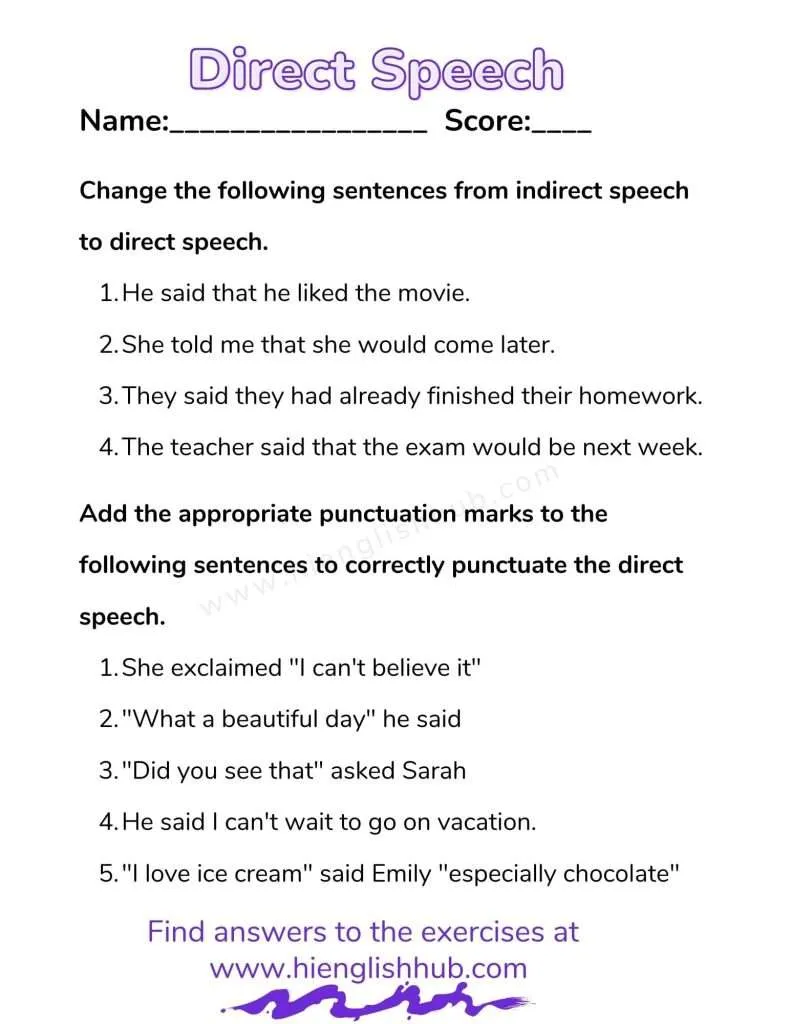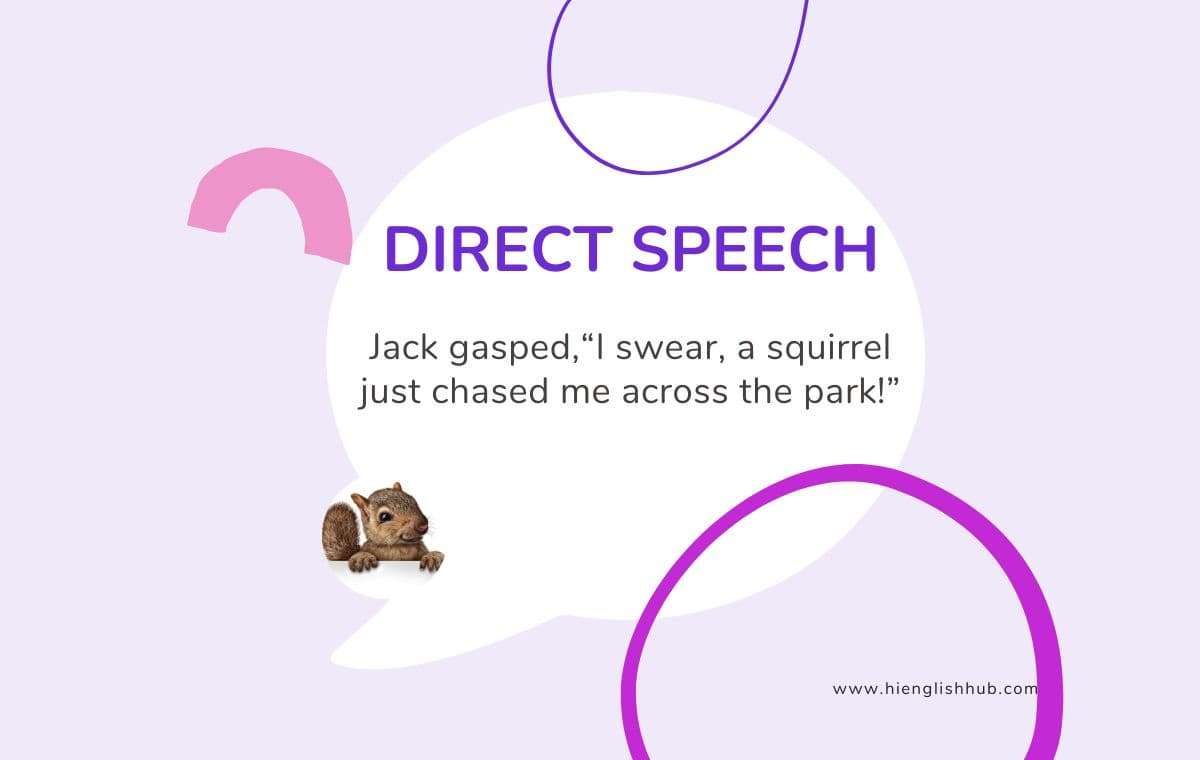The other day, my friend walked into class late and out of breath. As he sat down, he gasped, “I swear, a squirrel just chased me across the park!”
Yup, a squirrel! We all cracked up.
Now, notice how I used his exact words. That’s what we’re talking about today—direct speech.
So, stick around, and let’s dive into this fascinating topic together!
What Is Direct Speech?
In a nutshell, direct speech is when we use the same, exact words that someone else said.
It’s like a live broadcast of their thoughts!
Spot those quotation marks (‘…’) around what my friend said? Those are super important when we’re dealing with direct speech. They’re like little fences that say, “Hey, everything inside here is exactly what was said, no edits!”
But hang tight; we’ll dive more into this soon.
Direct Speech Rules
Direct speech has some rules, just like most things in English! But don’t worry; they’re pretty straightforward.
- Quotation Marks: When using direct speech, we always put the speaker’s words in quotation marks. These could be single (‘…’) or double (“…”), depending on what you prefer or what your teacher asks for.
- Capital Letters: The first word in direct speech starts with a capital letter. For example, John said, “I am happy.”
- End Punctuation: If there’s a full stop (.) or a question mark (?), or an exclamation mark (!) in the direct speech, it goes inside the quotation marks. Like this: He said, “What a lovely day!”
When Do We Use Direct Speech?
Alright, so you might be wondering, “When do I actually use direct speech?” Well, my friend, you’d be surprised how often it comes in handy!
Direct speech isn’t just for sharing hilarious squirrel chase stories. It’s a great tool to make your stories and writing more interesting. It can make your reader feel like they’re right there, listening to the conversation.
So whether you’re penning a tale of brave knights, retelling a funny family dinner conversation, or reporting a heated debate in your school council, direct speech is your secret weapon to add life and excitement to your writing!
Reporting Verbs In Direct Speech
You know what’s cool about using direct speech?
We have these things called ‘reporting verbs‘ to help introduce the speaker’s words.
“Said” is the most common one, but hey, it’s far from being the only one! Variety is the spice of life, right?
Imagine you’re sharing what your teacher said about your upcoming test. Sure, you could say: “My teacher said, ‘We have a test next Monday.'” But it could be much more fun and precise if you use a different reporting verb, like “announced” or “declared.” So, you could write: “My teacher announced, ‘We have a test next Monday.'”
Reporting verbs can be sneaky. They don’t just tell us that someone spoke; they can also tell us a bit about how or why they spoke. “Whispered,” “shouted,” and “muttered” give us an idea about the volume.
“Complained,” “joked,” and “bragged” tell us something about the speaker’s attitude.
So, next time you’re using direct speech, try swapping out “said” for a different reporting verb. You might be surprised at how much more colorful and interesting your writing becomes!
Direct Speech Examples
Let’s see some examples of direct speech that speak to your everyday life!
Picture yourself at a sleepover with your best friends, and someone suggests playing Truth or Dare. Your friend, Jake, gets really excited and yells, “Let’s start with truth or dare questions!” See that? You’ve just used direct speech to share Jake’s excitement!
Then, later in the evening, you all decide to switch games. Your friend, Mia, declares, “Never have I ever skipped a day of school!” That’s another example of direct speech right there.
The next day at school, your English teacher introduces a fun activity with tongue twisters. She instructs the class, “Repeat after me: ‘How much wood would a woodchuck chuck if a woodchuck could chuck wood?'” That’s direct speech, giving a lively peek into your classroom.
Let’s not forget about that homework that’s due tomorrow. You might overhear a classmate confess, “I always procrastinate until the last minute to do my homework.” Well, that’s direct speech too!
And, for the final touch, imagine your school principal sharing an inspirational quote during assembly. He could say, “Remember the wise words of Albert Einstein, ‘Education is not the learning of facts, but the training of the mind to think.'” With direct speech, you’re able to convey the quote exactly as it was given.
Differences Between Indirect And Direct Speech
Here’s a table comparing direct and indirect speech. It’s always great to see things side by side!
| Direct Speech | Indirect Speech | |
|---|---|---|
| Definition | Uses the exact words that were originally spoken. | Shares the essence of what someone said without quoting them exactly. |
| Punctuation | Uses quotation marks around the exact words spoken. | Doesn’t use quotation marks. |
| Example | Mom said, “You need to get more sleep!” | Mom told me that I needed to get more sleep. |
| Best Used When… | You want to convey the exact words or tone of the speaker. | You want to summarize or report on what was said. |
Indirect To Direct Speech Exercises

Change the following sentences from indirect speech to direct speech.
- He said that he liked the movie.
- She told me that she would come later.
- They said they had already finished their homework.
- The teacher said that the exam would be next week.
Answers:
- “I like the movie,” he said.
- “I will come later,” she told me.
- “We have already finished our homework,” they said.
- “The exam will be next week,” the teacher said.
Direct Speech Punctuation Worksheet With Answers
Add the appropriate punctuation marks to the following sentences to correctly punctuate the direct speech.
- She exclaimed “I can’t believe it”
- “What a beautiful day” he said
- “Did you see that” asked Sarah
- He said I can’t wait to go on vacation.
- “I love ice cream” said Emily “especially chocolate”
Answers:
- She exclaimed, “I can’t believe it.”
- “What a beautiful day!” he said.
- “Did you see that?” asked Sarah.
- He said, “I can’t wait to go on vacation.”
- “I love ice cream,” said Emily, “especially chocolate.”
FAQs On Direct Speech
Let’s answer some of the most common questions you might have about direct speech.
What Are 2 Examples Of Direct Speech?
1. Alice said, “I can’t wait for the school trip next week!”
2. The coach yelled, “Good job, team! Let’s keep this energy up!”
What Is An Example Of Direct And Indirect Speech?
Direct Speech: “I’m really tired,” John told me.
Indirect Speech: John told me that he was really tired.
How Do You Write A Direct Speech?
Writing direct speech is as easy as 1-2-3!
1. Start with the speaker’s name or a description of them.
2. Then, use a reporting verb (like ‘said,’ ‘shouted,’ and ‘whispered’).
3. Finally, write the exact words the speaker said inside quotation marks.
Here’s an example: John whispered, “I think there’s a monster under my bed!”
How Do You Teach Direct And Indirect Speech?
Teaching direct and indirect speech can be super fun, especially if you use interactive methods. Here are a few ideas:
a. Role Play: Have students act out a conversation using both direct and indirect speech. This can help them understand the differences.
b. Conversion Game: Give students sentences in direct speech and ask them to convert it into indirect speech, and vice versa.
c. Storytelling: Encourage students to write stories that use both direct and indirect speech. This can help them practice using these techniques in a creative context.
Final Thoughts On Direct Speech
We’ve reached the end of our exploration into direct speech. Hopefully, you now have a solid grasp of what it is and how it works. Now, it’s your turn to put it into practice!
If you found this information helpful or interesting, don’t keep it to yourself! Share this blog with your friends, colleagues, or anyone who might benefit from understanding direct speech better. Sharing is caring, after all!
Also, if you want to stay up to date with more language tips, tricks, and resources, be sure to follow Hi English Hub on Pinterest and Twitter.

